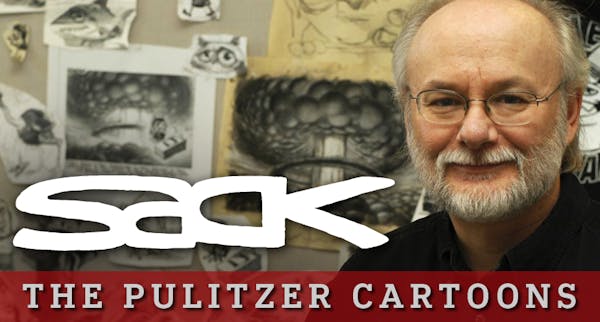Toasting the Star Tribune's well-deserved Pulitzer Prize for Local Reporting, Editor Nancy Barnes told a jubilant newsroom on Monday that "one of the things we stand for as an organization is a dedication to great journalism, and a dedication to journalism that makes a difference in people's lives."
Barnes praised the three writers of "The Day-Care Threat," Brad Schrade, Jeremy Olson and Glenn Howatt, as well as editor Dave Hage. She said the team "spent much of the past year working on uncovering why so many infants were dying in day-care homes, and shedding a light on that in a way that actually did make a difference."
Barnes kicked off Monday's celebration by congratulating editorial cartoonist Steve Sack, who also won. "What a joy we have," Barnes said, "Two Pulitzer Prizes. One goes to a man who has spent his life dedicated to a craft."
Accepting the accolades with characteristic modesty (and mirth), Sack said, "My job description is very simple; it's easy: I read the paper, crack a joke, draw a picture and turn it in. And that's it. But you folks have to know something, and I only know what I read in the newspapers."
Sack reads a stack daily — the Star Tribune, Wall Street Journal and New York Times, among others. He also keeps up with a range of columnists, blogs and magazines, and is a big movie buff.
But beyond reading and watching, he listens. "Some topics reach the general public conversation," Sack said. "When people are interested in a topic, well, I'm a 'people,' too."
But there's no set method to drawing five cartoons a week — more than 7,500 since he joined the Minneapolis Tribune in 1981.
"I wish I understood the process better. Or maybe it's good that I don't," Sack said. "In my crazy way, this is my form or art. Basically I draw these for myself. They have to interest me, an expression of how I look at the world, either how it is and how I don't like it, or how it is and how I want to change it."
Sack does understand, and appreciate, one key part of the process: artistic freedom. "In 32 years, I have not once been told by an editor or publisher what to draw or what not to draw," Sack said. "They've allowed me remarkable leeway on expressing myself, and I think that's the way an artist will do his best work."
His best work has essential elements. "The best cartoons are the ones that are simple, smart and funny, and an image that is unexpected."
Drawing U.S. presidents is a Sack signature, as it is for the fellow cartoonists he so admires. "When a new politician arrives on the scene, all the cartoonists try to 'get' him. You want the features to be recognizable immediately."
Some are harder. President George H.W. Bush (his son was easier). The most fun? "Nixon," said Sack, smiling.
But Sack's "all-time favorite to draw was [former Minnesota Gov.] Jesse Ventura, who was in some ways a walking cartoon and wrote most of the captions. He gave me a lot to work with, but I hope it wasn't done in a mean way, but having fun with how I saw that person."
That's Sack's standard approach. "I don't like to use a person's features as a weapon. I don't like to make a person look ugly. I don't mind making them look ridiculous, if that's the message and I perceive them as that. But I prefer the humor to come from the context of the message more than the way I draw someone."
Sack said he sees the world "as a cartoon." But, he added, he's not alone. "I draw caricatures, but many people have their own mental caricatures of people they don't know or understand or disagree with. And they're not always wrong, by the way."
Sack's prolific output is the product of hard work. Every day, on torn scratch paper, he draws multiple treatments of multiple topics. Once he's picked one, he turns to his iPad. It's a long way from when he used "a little bottle of ink and a crow-quill pen." But, Sack said, "The trick is not to let the tools take over, and still retain freshness you would get if you were still using pencil or pen on paper."
Sack is used to new forms. He's a sculptor (a piece was displayed at the State Fair) and painter ("very precise techniques, like Renaissance paintings of googly-eyes cartoon images — a combination of realism and the funny pages.")
But of his day job, Sack says "an editorial cartoon is not the comic page. It's not supposed to be funny every day." Indeed, his work can anger. But he tries to remember the advice of editor Charles Bailey, who hired him at the Tribune. "He said, 'Never be afraid of making people angry. But only make them angry when you intend it.' "
Sack is appreciative of the journalists whose work is the foundation for his cartoons. "These are professionals, and I realize that what a cartoonist does is entirely dependent on reporters, editors and photographers. Everything I comment on is information from someone else.
"I sit in my little office and draw my pictures and send them out to the world. I wouldn't be able to do that if it weren't for the people who make us look good — the layout people, the people at the presses. They all work so hard to make us look good."
------------------
John Rash is a Star Tribune editorial writer and columnist. The Rash Report can be heard at 7:50 a.m. weekdays on WCCO Radio, 830-AM.

Film festival shows the transformative power of art
NATO's strength in numbers makes U.S. more secure


